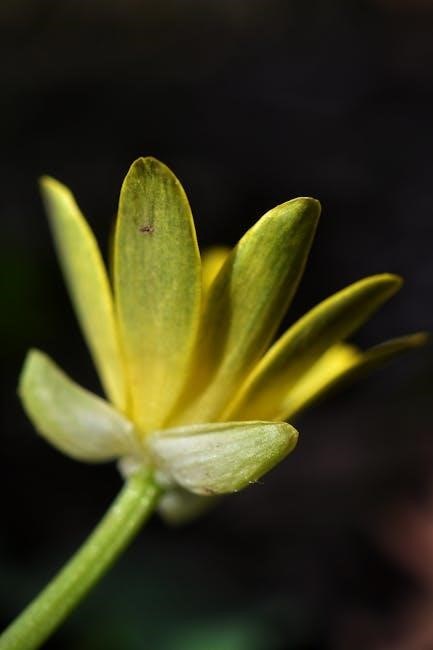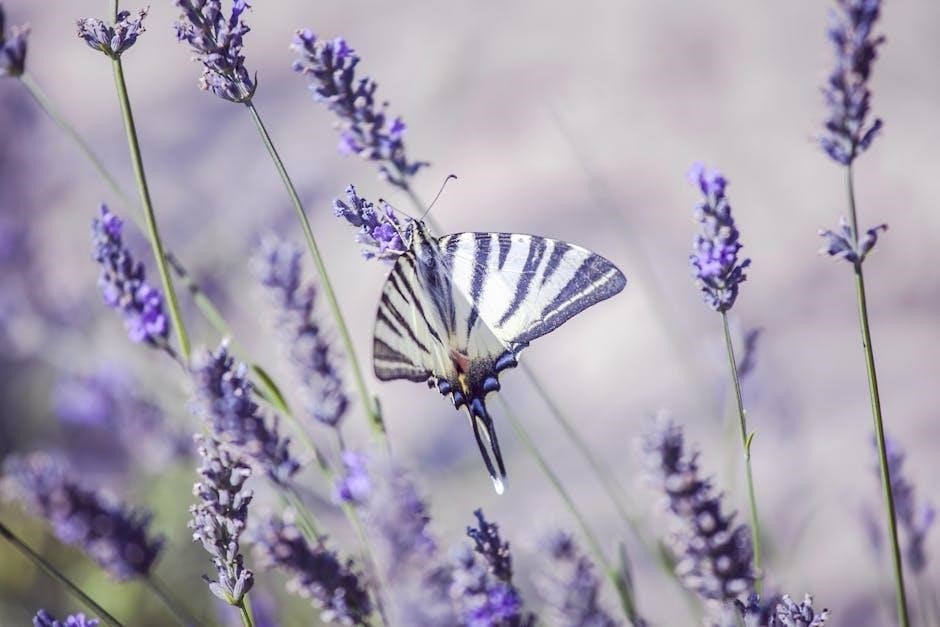
Welcome to the Zone 6B planting guide! This guide helps gardeners thrive in USDA Hardiness Zone 6B, with its moderate climate and distinct growing season. Learn about frost dates, soil preparation, and selecting the best plants for a successful garden in Zone 6B.
1.1 Overview of USDA Hardiness Zone 6B
USDA Hardiness Zone 6B has a moderate climate, with minimum winter temperatures ranging from -5°F to 0°F. This zone offers a relatively long growing season, typically from mid-April to mid-October. Gardeners in Zone 6B enjoy a balanced mix of cool and warm weather, allowing for diverse plant growth. The average last frost date in May and first frost in October provide ample time for planting a wide variety of vegetables, flowers, and perennials. This zone’s climate supports a vibrant and productive garden with proper planning and care.
1.2 Importance of Understanding Your Planting Zone
Understanding your planting zone is crucial for successful gardening. Zone 6B’s specific climate conditions determine which plants will thrive and when to plant them. Knowing the frost dates and temperature ranges helps avoid frost damage and ensures optimal growth. This knowledge allows gardeners to select suitable plants, plan planting schedules, and maximize yields. It also guides soil preparation and maintenance, ensuring a healthy and productive garden tailored to Zone 6B’s unique environment.

Growing Season in Zone 6B
Zone 6B’s growing season typically lasts from mid-April to mid-October, offering a moderate climate ideal for a wide variety of plants. This period allows ample time for planting and harvesting, making it suitable for both cool- and warm-season crops.
2.1 First and Last Frost Dates
In Zone 6B, the average last frost date is around May 10th, while the first frost date typically occurs near September 15th. These dates are crucial for timing plantings correctly.
Understanding frost dates helps gardeners avoid frost damage and ensures optimal growing conditions. Cool-season crops thrive before the last frost, while warm-season plants should be planted after this date.
2.2 Average Temperature Ranges
In Zone 6B, winter temperatures can drop as low as -5°F to 0°F, while summer highs often reach the mid-80s°F. These moderate temperature ranges allow for a diverse growing season, supporting both cool- and warm-season crops. Understanding these averages helps gardeners plant appropriately, ensuring optimal growth and avoiding temperature-related stress for plants.

Planting Calendar for Zone 6B
This calendar provides a month-by-month guide for planting vegetables, flowers, and perennials in Zone 6B, ensuring optimal growth and harvest timing based on seasonal patterns and frost dates.
3.1 Spring and Early Summer Planting
Spring and early summer are ideal for planting a variety of crops in Zone 6B. Cool-season vegetables like broccoli, spinach, and lettuce thrive in early spring, while tomatoes, peppers, and zucchini excel in late spring. Start seeds indoors 4-6 weeks before the last frost date for a head start. Succession planting ensures continuous harvests. Plant root crops like carrots and beets directly in the ground as soon as the soil can be worked. This period offers ample opportunity to diversify your garden for a bountiful harvest.
3.2 Fall and Late-Season Planting
Fall and late-season planting in Zone 6B offers a second chance for a bountiful harvest. Cool-season crops like kale, spinach, and carrots thrive in cooler temperatures. Plant seeds for root vegetables and brassicas 8-10 weeks before the first frost date. Succession planting ensures a continuous yield. Start seeds in late summer for fall harvests and direct sow in early fall for hardy greens. Use cold frames or hoop houses to extend the growing season and protect crops from frost, maximizing your garden’s productivity well into autumn.

Soil Preparation and Maintenance
Soil preparation in Zone 6B involves testing pH levels and adding organic matter like compost. Maintain pH between 6.0-7.0 for optimal plant growth, avoiding over-fertilization.
4.1 Understanding Soil Types in Zone 6B
In Zone 6B, common soil types include loam, clay, and sandy soils. Loam is ideal for most plants, offering good drainage and fertility. Clay soils retain moisture but may require amendments for better drainage, while sandy soils drain quickly but need organic matter to retain nutrients. Testing your soil type and pH is crucial for optimal plant growth. Zone 6B soils often range from slightly acidic to neutral (pH 6.0-7.0). Understanding your soil type helps tailor preparation and amendments for a thriving garden.
4.2 Soil Amendments and Fertilization
Soil amendments and fertilization are key to maximizing plant growth in Zone 6B. Adding compost or well-rotted manure enriches the soil with nutrients and improves its structure. Balanced fertilizers (10-10-10) are ideal for most plants, applied during planting and again mid-growing season. Organic matter like leaf mold or aged manure enhances soil fertility and promotes healthy root development. Regular soil testing ensures optimal nutrient levels, while targeted amendments address specific deficiencies, fostering a productive and thriving garden in Zone 6B.
4.3 Optimal Soil pH Levels for Zone 6B Plants
The ideal soil pH for most plants in Zone 6B ranges from 6.0 to 7.0, slightly acidic to neutral. Vegetables like tomatoes and cucumbers thrive in this range, while blueberries prefer more acidic soil (4.5-5.5). Regular soil testing is essential to determine pH levels and guide adjustments. Lime can raise pH, while sulfur lowers it. Avoid over-correction, as drastic changes can harm plant health. Maintaining a balanced pH ensures nutrient availability and supports robust growth for a wide variety of Zone 6B plants.

Selecting the Right Plants for Zone 6B
Zone 6B offers a versatile climate for growing a wide variety of plants, including vegetables, flowers, and perennials. Choosing plants suited to this zone ensures optimal growth and productivity.
5.1 Vegetables Suitable for Zone 6B
Zone 6B’s moderate climate supports a variety of vegetables, including tomatoes, peppers, cucumbers, zucchini, and carrots. Leafy greens like spinach and kale thrive in cooler months, while beans, radishes, and turnips grow quickly. Root vegetables like beets and potatoes are also ideal. Start seeds indoors for longer-maturing plants like tomatoes and peppers. Succession planting extends the harvest season for crops like lettuce and radishes. Proper soil preparation and timing based on frost dates ensure a bountiful harvest in Zone 6B.
5.2 Flowers That Thrive in Zone 6B
Zone 6B’s climate is perfect for a wide range of flowers. Perennials like coneflowers, black-eyed Susans, and daylilies bloom vibrantly. Annuals such as marigolds, zinnias, and petunias add color and variety. Bulbs like tulips and daffodils thrive in Zone 6B’s cool winters and warm summers. Choose flowers with varying bloom times for year-round beauty. Ensure plants receive adequate sunlight and well-draining soil. Proper care and timing will create a stunning, resilient garden in Zone 6B.
5.3 Best Perennials for Zone 6B Gardens
Zone 6B’s moderate climate supports a variety of vibrant perennials. Black-eyed Susans, coneflowers, and lavender are drought-tolerant and attract pollinators. Hostas and astilbe thrive in shade, while sedum and yarrow excel in full sun. Coral bells and catmint add foliage and color. Plant peonies or hydrangeas for stunning blooms. These perennials are hardy, requiring minimal care once established. Choose a mix to ensure continuous beauty from spring to fall, leveraging Zone 6B’s ideal growing conditions for a dynamic garden display.

Garden Maintenance Tips
Regular watering, mulching, and weed control are essential for maintaining a healthy garden in Zone 6B. Proper sun exposure and soil care ensure optimal plant growth and longevity.
6.1 Watering Strategies for Zone 6B
Water plants deeply once or twice a week, depending on rainfall. Avoid frequent shallow watering to encourage deep root growth. Use soaker hoses or drip irrigation for efficiency. Check soil moisture by inserting a finger or trowel. Water in the morning or evening to minimize evaporation. Adjust watering based on weather conditions, reducing frequency during cooler or rainy periods. Proper hydration supports healthy growth and resilience against pests and diseases in Zone 6B gardens.
6.2 Managing Sun Exposure and Shade
Understanding sun and shade requirements is key for thriving plants in Zone 6B. Most vegetables and flowers need 6-8 hours of sunlight daily. Place shade-loving plants, like ferns or hostas, in areas with filtered sunlight. Use trees or trellises to create shade for sensitive plants. Rotate plantings to optimize sun exposure and prevent overcrowding. Monitor sunlight patterns throughout the day to ensure proper placement. Balancing sun and shade ensures healthy growth and maximizes garden productivity in Zone 6B.
6.3 Mulching and Weed Control
Mulching is essential for retaining soil moisture and suppressing weeds in Zone 6B gardens. Use organic mulches like wood chips or straw, applied 2-3 inches thick. Avoid mulching too close to plant stems to prevent rot. For weed control, manually remove weeds regularly or use pre-emergent herbicides. Landscape fabric can also help block weed growth while allowing water and air to reach plants. Proper spacing and timely mulching ensure a weed-free, thriving garden throughout the growing season.

Pest Control and Common Challenges
In Zone 6B, common pests like aphids, slugs, and snails can damage plants. Use organic controls like neem oil or hand-picking to manage infestations. Frost damage is a key challenge; protect plants with covers during late frosts. Regular monitoring and preventive measures like crop rotation help maintain plant health and reduce pest issues.

7.1 Common Pests in Zone 6B Gardens
Zone 6B gardens often encounter pests like aphids, slugs, and snails, which can damage plants. Aphids target tender shoots, while slugs and snails chew holes in leaves at night. Other common pests include caterpillars, beetles, and spider mites. These pests can weaken plants and reduce yields if left unchecked. Early identification and organic controls, like neem oil or hand-picking, are essential for maintaining healthy plants and preventing infestations from spreading.
7.2 Dealing with Frost Damage
Frost damage is a significant concern in Zone 6B, especially for tender plants. Protect vulnerable plants by covering them with blankets or bringing potted plants indoors during frost events. Use cold frames or hoop houses for extended protection. If frost damage occurs, inspect plants for blackened or wilted leaves, and prune affected areas to promote healthy regrowth. Avoid overwatering during recovery, as this can further stress plants. Proper planning and protection can help mitigate frost-related challenges in your Zone 6B garden.

Season Extension Techniques
Extend your growing season in Zone 6B using cold frames, hoop houses, and succession planting. These methods protect crops from frost and maximize harvest duration effectively.
8.1 Using Cold Frames and Hoop Houses
Cold frames and hoop houses are excellent tools for extending the growing season in Zone 6B. These structures protect plants from frost and provide a warmer environment for growth. Cold frames are typically made of wooden or plastic frames with clear lids, while hoop houses use arched PVC or metal pipes covered with plastic. Both options allow gardeners to grow cool-weather crops like spinach and kale well into fall. For best results, place them in sunny areas and ensure proper ventilation to prevent overheating. DIY options, such as repurposing old windows or using milk jugs, can also be effective for small-scale season extension.
8.2 Succession Planting for Extended Harvests
Succession planting is a powerful strategy to maximize harvests in Zone 6B. By sowing crops in sequential intervals, gardeners can enjoy continuous yields throughout the growing season. Plant fast-maturing varieties like leafy greens, radishes, and beans every 1-2 weeks. After harvesting summer crops, use the remaining warm weather to plant cool-season crops like spinach or kale. This method ensures optimal use of space and time, allowing for multiple harvests from the same bed. It also helps prevent pests and diseases by avoiding overloading the soil with a single crop for too long.